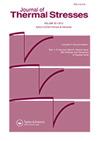重金属胁迫下脱落酸的代谢、信号传导及与其他植物激素的串扰
IF 2.6
3区 工程技术
Q2 MECHANICS
引用次数: 0
摘要
重金属胁迫对作物、生态系统和人类健康构成全球性风险。它破坏细胞离子平衡、细胞膜完整性、代谢平衡以及酶和蛋白质的活性,严重影响生理过程、植物发育和农业生产力。虽然植物自然激活防御机制来减轻HM胁迫的不利影响,但它们不能完全阻止它们。植物激素对抗HM毒性,帮助生长。外部应用和通过信号/生物合成基因的内部调节可以防御hm诱导的损伤。在植物对环境胁迫(包括HM毒性)的适应性反应中,一个关键的信号分子是脱落酸(ABA)。尽管ABA在干旱和盐胁迫等非生物胁迫反应中发挥作用,但其在HM胁迫下的功能及其与其他植物激素的相互作用尚不清楚。尽管如此,外源应用ABA可以通过促进渗透物积累和增强抗氧化活性来增强植物对HM毒性的抗性。ABA对不同环境条件下植物的生长和代谢活性具有显著的调节作用。本文重点介绍了HM胁迫对植物的影响,并探讨了ABA在植物组织内的产生、信号传导、分解代谢和运输中的作用。本文的目的是阐明在HM暴露过程中ABA的代谢、信号传导及其与其他植物激素(如生长素、赤霉素和乙烯)的相互作用之间的复杂相互作用。此外,我们还深入研究了ABA减轻HM胁迫的功能,并阐明了其与其他植物激素的相互作用。本文章由计算机程序翻译,如有差异,请以英文原文为准。
Abscisic Acid: Metabolism, Signaling, and Crosstalk with Other Phytohormones under Heavy Metal Stress
Heavy metal (HM) stress poses a global risk to crops, ecological systems, and human health. It disrupts cellular ionic equilibrium, cell membrane integrity, metabolic balance, and the activities of enzymes and proteins, severely impacting physiological processes, plant development, and agricultural productivity. Although plants naturally activate defense mechanisms to mitigate the adverse effects of HM stress, they cannot completely prevent them. Phytohormones counter HM toxicity, aiding growth. External application and internal regulation via signaling/biosynthesis genes offer defense against HM-induced damage. A pivotal signaling molecule in plant adaptive responses to environmental stressors, including HM toxicity, is abscisic acid (ABA). Despite ABA’s role in abiotic stress responses such as drought and salinity, its function and crosstalk with other phytohormones under HM stress remain poorly understood. Nonetheless, exogenously applied ABA serves as a strategic approach to enhancing plants’ resistance to HM toxicity by promoting osmolyte accumulation and reinforcing antioxidant activity. ABA significantly regulates various plant growth and metabolic activities under diverse environmental conditions. This review highlights the effects of HM stress on plants and explores ABA involvement in production, signaling, catabolism, and transport within plant tissues. The purpose of this paper is to shed light on the complex interplay between the metabolism of ABA, its signaling, and its interactions with other phytohormones (e.g., auxins, gibberellins, and ethylene) during HM exposure. Furthermore, we delve into the function of ABA to mitigate HM stress and elucidate its interactions with other phytohormones.
求助全文
通过发布文献求助,成功后即可免费获取论文全文。
去求助
来源期刊

Journal of Thermal Stresses
工程技术-力学
CiteScore
5.20
自引率
7.10%
发文量
58
审稿时长
3 months
期刊介绍:
The first international journal devoted exclusively to the subject, Journal of Thermal Stresses publishes refereed articles on the theoretical and industrial applications of thermal stresses. Intended as a forum for those engaged in analytic as well as experimental research, this monthly journal includes papers on mathematical and practical applications. Emphasis is placed on new developments in thermoelasticity, thermoplasticity, and theory and applications of thermal stresses. Papers on experimental methods and on numerical methods, including finite element methods, are also published.
 求助内容:
求助内容: 应助结果提醒方式:
应助结果提醒方式:


